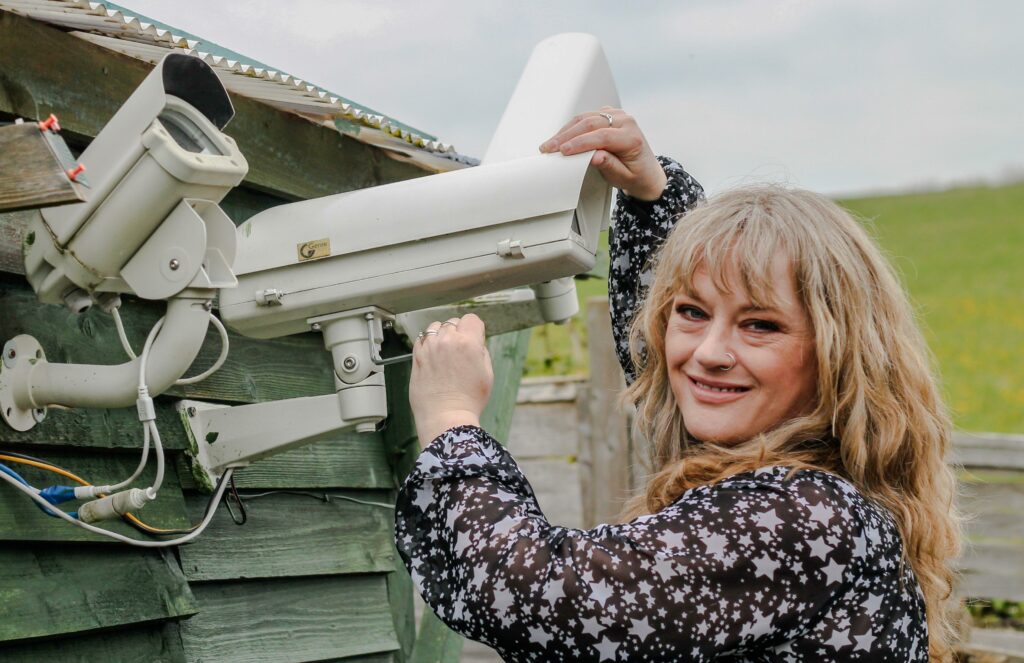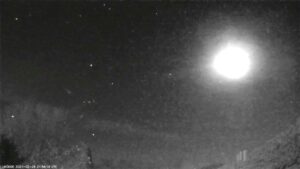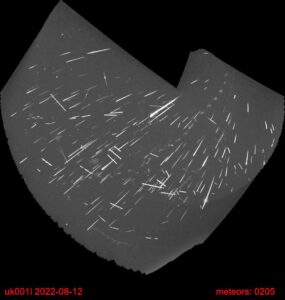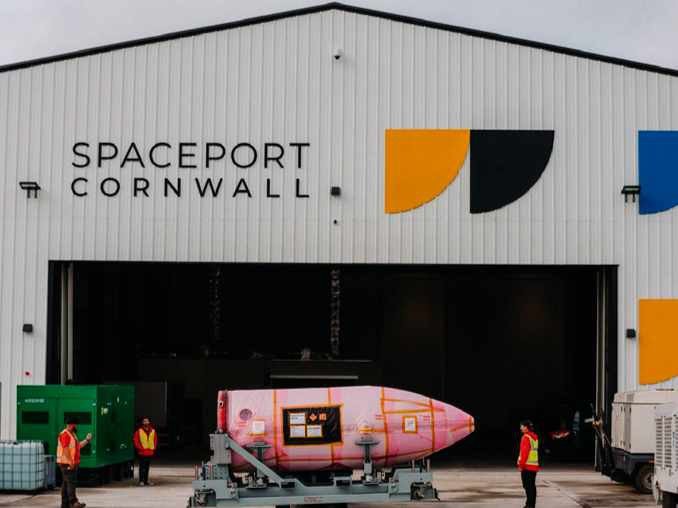The Sky at Night TV show, past, present and future
Inside The Sky at Night
In May’s episode of The Sky at Night, Mary McIntyre explained how basic home CCTV cameras can play a big part in meteor science


When my husband and I set up our first meteor camera back in 2018, we did it not only to learn more about the orbits of the meteor events we observed and captured with our DSLR cameras, but also to see what we were missing while we slept. We loved our first meteor camera so much that we soon set up three more and we now have almost full sky coverage. We had no idea back then just what an important and valuable contribution they would make to so many aspects of meteor and asteroid science.
A meteor is the streak of light we see when a piece of space debris burns up in our atmosphere; a fireball is a meteor that has a magnitude greater than –4.0. Most fireball meteors are asteroid debris, unlike meteor showers which usually originate from comets (the only exception being the Geminids).

The cameras we use to observe meteors are inexpensive CCTV cameras that are capable of capturing low-light images and video. Although basic, they really pack a punch! They’re able to detect events down to mag. +6.0 over an approximately 90˚ field of view. They are connected to a Raspberry Pi computer that is running the free, open-source software from the Global Meteor Network (GMN). The cameras record from dusk until dawn every night and any potential meteor events are saved. The following morning, the software uses a machine learning algorithm to eliminate anything that is not a meteor, then the analysis begins.
The data from multiple cameras is combined and if cameras from different locations have detected the same meteor, it can be triangulated. This means we then have an orbit solution, trajectory, velocity, direction of travel, magnitude and luminous mass estimates for that meteor. In the UK, all of this data is stored in the UK Meteor Network online archive. If a fireball meteoroid was large enough to survive and drop meteorites on the ground, scientists use camera data plus computer modelling to calculate a potential fall zone.
Face-on to a fireball
On 28 February 2021, a mag. –7.9 fireball was seen by thousands of people across the UK and it was captured on several meteor cameras, including ours. The view from our camera was head-on to the fireball so it was impossible to get any trajectory analysis from it. Luckily, other cameras got a much better view of it (this is why we need lots of cameras!) and the data from six camera networks resulted in the recovery of a pristine carbonaceous chondrite meteorite. This was the first witnessed meteorite fall in the UK for 30 years and it was incredible to be a part of that. Also thanks to meteor camera data, meteorites were recovered from the northern coast of France after the impact of the one-metre diameter asteroid 2023 CX1 on 13 February 2023.
Approximately 65,000 meteorites have been found on Earth, but we only know the original orbits of about 50 of them. Data from the camera networks is giving us that valuable information. Worldwide data from the Global Meteor Network gives us accurate meteor rates and has even resulted in the discovery of new meteor showers. NASA and ESA are also using the data to help keep spacecraft and astronauts safe.
It’s incredible how much important science is being done with these little CCTV cameras, and we love being part of this citizen science project. The videos and images from the cameras are awesome for outreach and it’s exciting because you never know when the next interesting event will occur.
Find Mary’s guide to setting up your own meteor camera on our website at bit.ly/meteor-detector

Mary McIntyre is an outreach astronomer and teacher of astrophotography
Looking back : The Sky at Night
23 June 1967

In the 23 June 1967 episode, Patrick turned his attention to one of the brightest stars in the night sky: Vega.
Vega is an A-type star with a surface about 4,000˚ hotter than the Sun, giving it a slightly blue tint. It is just over twice the mass of the Sun and about half-way through its expected one-billion-year main-sequence lifespan.
Its brightness, proximity and high position from northern latitudes mean Vega is one of the most studied stars. In 1872, astronomer Henry Draper chose it as the first star to have its spectra taken (after our Sun). These images showed four of the spectral lines of hydrogen emission, indicating that the star was made of the element. Vega is also very important to astronomers, being the original benchmark against which all other stellar magnitudes were calculated.
So it might be surprising to hear that Vega is actually a variable star, fluctuating by around 0.03 magnitudes every 2.5 hours. Vega’s apparent brightness is also changing as the star is getting closer to Earth. Currently, it is around 25 lightyears away, but will get to within about half that distance around 210,000 years from now, and could reach a magnitude of –1.0. Its position in the night sky will appear to change much faster, however, due to the precession of the equinoxes, which causes the northern celestial pole to wobble. Around 12,000 BC, Vega was the pole star and it will reclaim this position in another 13,700 years.

JUNE
Blast Off: A User’s Guide to Space Travel
The Sky at Night team look at the UK’s booming space industry as they find out how to build a rocket with one of the companies hoping to be the first to launch from British soil. They also learn how satellites are being tested to withstand the harsh conditions of space, and about their impact on our night skies.
BBC Four, 12 June, 10pm (first repeat will be on BBC Four, 15 June, 7pm) Check www.bbc.co.uk/skyatnight for more up-to-date information
